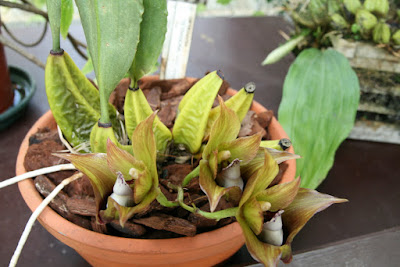Bifrenaria tetragona is endemic to the mountain forests on the southeastern coast of Brazil (Rio de Janeiro, São Paulo). Its habitat is the rocks exposed to the sun, in montane rainforests at elevations of 300 to 1200 meters...
Bifrenaria tetragona also called as The Rectangular Bulbed Bifrenaria, Bifrenaria calcarata, Bifrenaria tetragona var rupicola, Bifrenaria tetragona var umbrophila, Cydoniorchis tetragona, Epidendrum calcaratum, Lycaste tetragona, Maxillaria tetragona, is a species of the genus Bifrenaria. This species was described by Rudolf Schlechter in 1914.
IDENTIFY BIFRENARIA TETRAGONA
Bifrenaria tetragona is endemic to the mountain forests on the southeastern coast of Brazil (Rio de Janeiro, São Paulo). Its habitat is the rocks exposed to the sun, in montane rainforests at elevations of 300 to 1200 meters.
It is a medium sized, warm to cool growing lithophyte with ovoid, 4 angled pseudobulbs carrying a single, apical, plicate, fleshy, narrowly elliptic leaf.
The Rectangular Bulbed Bifrenaria blooms in the spring and summer on a short, racemose, 3 to 4 flowered inflorescence arising on a newly matured pseudobulb and carrying fragrant waxy, long-lasting flowers. The flowers are about 5 cm in diameter and smell strange, unpleasant, but fortunately not strong.
BIFRENARIA TETRAGONA CARE AND CULTURE
Cultural information should only be used as a guide, and should be to be adapted to suit you. Your physical location; where you grow your plants, how much time you have to devote to their care, and many other factors, will need to be taken into account. Only then can you decide on the cultural methods that best suit you and your plants.
Light:
Bifrenaria tetragona needs very high light intensity: from 40000 to 60000 lux. 4-5 hours a day of direct sun are almost essential, otherwise you have to provide it with artificial lighting. The photoperiod should be 12-14 hours.
Temperature:
It is an intermediate-hot greenhouse species. The recommended summer temperatures are 25-27 ° C during the day and 19-20 ° C at night, while in winter they are lowered at 21-22 ° C during the day and 14-16 ° C at night.
Humidity:
Being cultivated in pot, it does not need high humidity, and the usual 50-55% are good. In the case of the raft the speech changes, and the required values of air humidity are 75-80%.
Substrate, growing media and repotting:
Bifrenaria tetragona can be placed either in vase or bare root, but given its size, a vase is more practical. Medium-sized pine bark can be used as a substrate. By placing it on a raft let's not forget to put a little sphagnum under its roots.
This orchid absolutely does not love repotting. It is only repotted when it is really necessary (for example, the substratum has "aged" and started to decompose, which happens every 3-4 years, or there have been problems with the roots), taking care not to damage the roots if possible.
Watering:
During the period of growth (from March to November) the plant gets water when the substrate has dried well but has not yet become completely dry. We must prevent water from remaining on the buds of the new pseudobulbs, because it could cause their rot.
Fertilizer:
This species is fertilized with 1/4 of the dose indicated on the vial of a suitable liquid fertilizer for orchids. Toward the maturation of young pseudobulbs and the beginning of the rest period (that is, more or less in September), I recommend fertilizing it with a fertilizer containing more nitrogen phosphorus. The phosphorus accumulated in the pseudobulbs before the winter period will push the orchid to bloom after the rest period.
Rest period:
Bifrenaria tetragona flower in the period from the end of winter to the beginning of summer, from the last pseudobulbs formed before the rest period. From November to March this species should be subjected to a certain period of rest with lower temperatures and wetting substituted with rather light substrate sprays once every 7 days. The air humidity during this period must be 70-80%, the light 35000-40000 lux, and the photoperiod of 11 hours. As soon as you see the buds of the new pseudobulbs or floral stems, we must start again the watering and gradually raise the temperatures. During the rest period the orchid does not fertilize.















COMMENTS